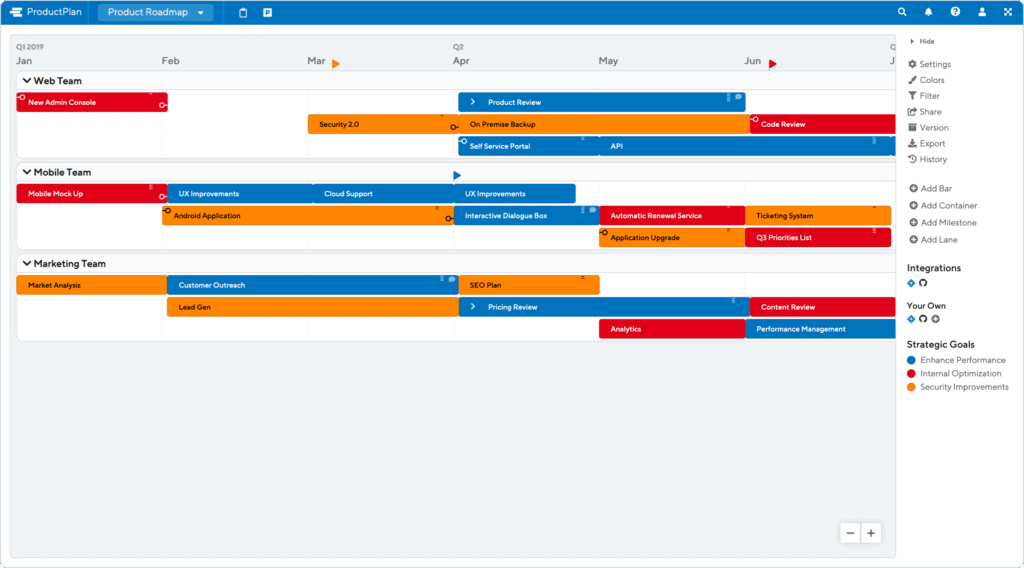You’ve got a new feature or product to build. You need to evaluate an effective roadmapping tool to help you stay on track. But how do you know which one will support your specific needs?
Building a product roadmap that serves the needs of the product team and the team’s various constituents can be challenging without the right purpose-built roadmap tool.
Why Use a Roadmapping Tool?
We’ve seen product teams use Powerpoint, spreadsheets, and everything in between to build and share their product roadmaps, so why use a roadmapping tool?

Because a product roadmap maps out the vision and direction of your product, it plays a key role in its success. A roadmap communicates the “why” behind what you’re building. But that’s not all. An effective roadmap should also:
- Describe the product vision and strategy
- Provide a guiding document for executing the strategy
- Align internal stakeholders
- Facilitate discussion of options and scenario planning
- Help communicate with external stakeholders, including customers.
Robert Villa, Gartner research director, reports:
“Gartner often sees technology and service provider product roadmaps that don’t communicate the right information to the intended audience, whether that be clients, sales, executives, or even Gartner analysts.”
When misused, Villa continues, product roadmaps can result in customer loss, slowed sales cycles, confusion, external breaches of sensitive and confidential information, and an increased dev workload.
These are all compelling reasons to make sure you pick the right roadmapping solution that fits your team and product strategy.
As you evaluate roadmapping tools, use these key questions to help you reflect on and match your organization’s needs with the best tool.

Question 1: What do you need to communicate (and with whom)?
If you don’t have a clear idea of what you want to communicate or who you need to reach, picking a roadmapping tool will be challenging.
Start by clarifying who the roadmap will serve. Will it be just for your team’s use, or will it be shared more broadly within the organization? Consider whether or not executive management or your customers will need to see it. If you plan to share widely internally and externally, you’ll want to pick a solution that makes it easy to share.
Check out our recent webinar to discover the key ingredients of a successful roadmap:
Ideally, your product roadmap should convey the strategic direction for your product. And it should also tie back to the strategy for the company. Within that framework, of course, is the general order of what you’ll be building.
Here are four examples of roadmap constituencies and the primary function a roadmap serves for them:
Internal Roadmap for Execs
These roadmaps should focus on high-level strategic concepts — such as driving growth, new market penetration, customer satisfaction, or market position — to secure buy-in for the product vision and maintain support and enthusiasm throughout its development cycle.
Although similar to executives, roadmaps for investors and board members should emphasize how the planned work will increase the product (and company).
Internal Roadmap for Engineers
These roadmaps often focus on features, releases, sprints, and milestones. They’re typically more granular in scope and shorter in duration than executive-facing roadmaps. For those using agile development methods, these roadmaps are often at the epic or feature level. However, product goals and themes should still be a component of these roadmaps.
Internal Roadmap for Sales
Sales teams will want to know how the product will help them sell more, so the focus here should be on a combination of features and customer benefits. Focus on how the product will benefit reps directly and the user benefits they can communicate to their customers and prospects. Whenever possible, group similar features/items into themes that sales reps can discuss with prospects.
External Roadmap for Customers and Prospects
When designing a product roadmap for customers and prospects, the focus should be entirely on the product’s benefits to them. Because these are external documents, customer roadmaps should be visual, attractive, and easy to understand.
You can browse a variety of examples of product roadmap templates here.
Question 2: How easy does maintenance and monitoring need to be?
Given that 41% of product managers revise their roadmaps monthly, you need to understand a roadmapping tool’s functionality and ease of use before you commit.
Think about how frequently you’ll want to have updated information. How much time do you anticipate having to spend updating your roadmap? Some roadmap activities can be time-consuming if you’re not careful.
If you currently use other tools like Jira, Trello, and Slack, consider whether you’d like to integrate them with your roadmapping solution. You can save valuable time and streamline processes by picking a roadmapping solution that seamlessly integrates with the tools you and your team already know and use.
Check out our collection of product integrations.
Question 3: How secure is the roadmapping tool?
Product roadmaps contain sensitive company and product information that you certainly don’t want falling into the wrong hands–namely your competition.
Select a roadmapping tool that takes data security seriously by ensuring you have full control of how and when you share your roadmap and require a secure login or a private link.
Question 4: What would the change management look like?
Introducing a new tool can be quite a task, regardless of the size of the organization. Look for training opportunities with a new roadmapping tool. Will the solution provider help you get you and your team up and running easily? Find out how easy it will be to get your current roadmap information into the new one. If you use spreadsheets, for example, is there an easy way to import?
A seamless transition and hands-on expertise will save you many hours of frustration (and probably a few headaches).
Question 5: Are there particular features you need?
Your organization’s needs are unique to you, so when you’re evaluating a roadmap tool, it should reflect that.
For example, some organizations prefer to use branded colors on their roadmaps. Is this important to you?
Not every person on a team needs to be able to edit the roadmap. Does a roadmapping tool have the ability to limit permissions and easily allow for view-only access?
What about customer feedback and feature requests — will you need a way to organize external feedback and requests within your roadmapping tool?
Prioritizing potential features before putting them on your roadmap is crucial. Would it be helpful to do that in your roadmapping tool, too?
Don’t settle for less: A good roadmapping tool will match your unique needs.
Best Practices for Building a Product Roadmap
Once you’ve evaluated and selected a roadmapping tool, settled on your product vision, and prioritized all your initiatives, you’ll need to start actually building your roadmap. Here are a few best practices to keep in mind.
Visual
A high-level visual presentation is a powerful way to help get buy-in on your strategy. This is one reason a visual product roadmap is a good way to go.
Collaborative
Building a product roadmap often has to be a fluid conversation—a compromise among different priorities. A common way to collaborate during the build phase is to enable each stakeholder to lead their initiatives within their respective areas.
Dynamic
A product roadmap is a high-level strategic document that reflects your long-term product vision, but a roadmap does not need to be set in stone. You have to be able to update your roadmap frequently if you need to adjust your direction.
In an agile world, you can no longer predict what’s going to happen years out. You need to adjust to market changes, customer requirements, stakeholder needs, and other influences rapidly. Therefore your roadmap needs to be a living document and allow for changes.
How often you change your roadmap depends on how many details you include on your roadmap, and as well as the timeframe for the roadmap. For example, if your roadmap tends to be long-term (more than 12 months) and is at a higher strategic level, it may not change as frequently as a short-term roadmap with detailed features.
We hope this helps you clarify your needs and expectations as you evaluate the right roadmapping tool for your organization.
Want to explore what roadmaps you can build in ProductPlan? Download our template guide.




